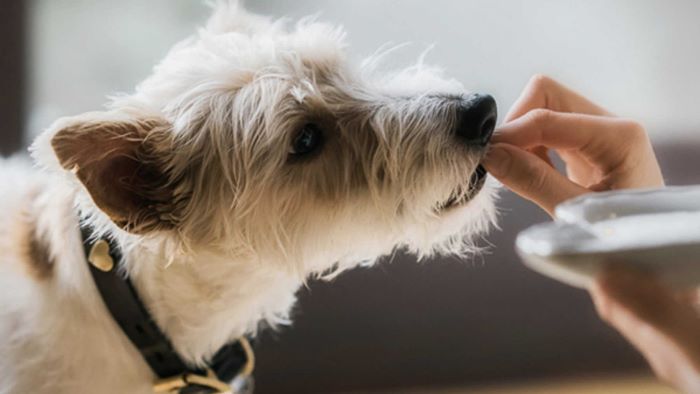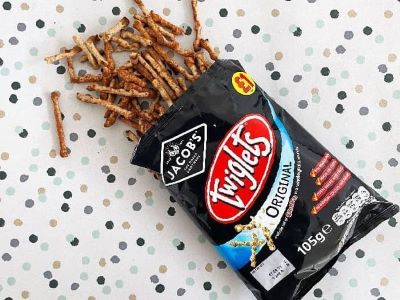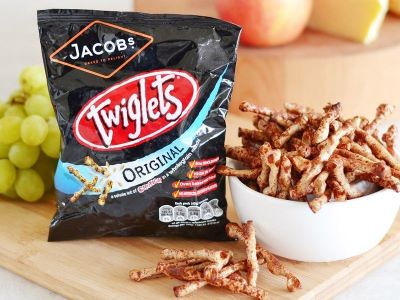Twiglets are tasty crunchy stick snacks that some love and others may find odd. They have unique marmite extract flavours, but “Can Dogs Eat Twiglets?“🐶
In this blog, we are going to find out how twiglets affect dogs. And how can we feed them this treat? So, without any further due let’s dive into the food world.

Can Dogs Eat Twiglets?
Twiglets like all the other snacks have many ingredients. So, it’s crucial to understand what are these ingredients, let’s look at them in detail:
- Whole wheat can be a good source of fibre for dogs, aiding in digestion. Some dogs may be sensitive to gluten, so watch out for any adverse reactions.
- Often used for flavour, yeast extract itself is not harmful to dogs in moderation. Excessive amounts may cause digestive upset.
- Dogs have a lower tolerance for salt than humans. Excessive salt can lead to sodium ion poisoning[1]. Twiglets’ seasoning may be too salty for dogs, limit intake to prevent health issues.
- Small amounts of vegetable oils can be acceptable, providing healthy fats. Excessive fat intake can lead to pancreatitis, so moderation is the key here.
- These are commonly used to make snacks rise during baking. While generally safe, excessive consumption may cause minor stomach upset.
Nutritional Needs of the Dog
Understanding what dogs need in their diet is crucial for making the right choices about Twiglets and other snacks. Dogs require protein for muscle maintenance and overall health.

Complete Twiglets with protein-rich dog-friendly treats or foods. A source of energy, especially important for active dogs. Whole wheat in Twiglets can contribute, but be mindful of gluten sensitivities. Essential for skin health and a shiny coat. 🐶
Twiglets’ vegetable oils provide some fats but watch overall fat intake. Support various bodily functions and overall well-being. Ensure a balanced diet, by mixing Twiglets with nutrient-rich dog-friendly foods.
Always provide fresh water, especially if offering dry snacks like Twiglets.
Risks and Concerns
Dogs can not eat all the snacks like us humans do, in the same way, there may be some risks connected with dogs eating twiglets. Let’s understand it in detail:
Smaller dogs may be more susceptible to the effects of certain ingredients due to their size. Adjust portions based on your dog’s size, and consider breed-specific sensitivities.
- Salt Content: Twiglets often contain salt for flavour, but dogs have a lower tolerance than humans. Excessive salt can lead to sodium ion poisoning, causing symptoms like vomiting, diarrhoea, and lethargy.💤
- Yeast Extract: While generally safe, large amounts of yeast extract may cause digestive upset. Watch out for signs of discomfort, such as bloating or gas, and adjust portions according to your dog’s needs.
- Artificial Seasonings: Twiglets may include artificial seasonings for enhanced taste. Some additives can be harmful to dogs, avoid snacks with onion or garlic powder, as they can be toxic.
- Spices and Herbs: Seasonings like garlic or onion can be present in snack foods. Both garlic and onion are known to be toxic to dogs, potentially causing damage to red blood cells” confirms the experts from VCA Hospitals.🏥
- Enhancing flavours: Twiglets might contain monosodium glutamate (MSG) or similar additives. Dogs may react negatively to MSG, experiencing symptoms like restlessness, panting, or vomiting.

Always read the ingredient list and look out for elements like onion, garlic, excessive salt, or artificial flavourings.
To avoid these risks, Don’t make twiglets a regular part of your dog’s diet.
Always prioritize your dog’s well-being by understanding their needs and choosing treats wisely.
Safe Alternatives
Instead of Twiglets, healthier treat alternatives for dogs include Lean-cooked meats like chicken or turkey – high protein, low additives.
Vegetables like carrots or green beans – are low in calories, and high in fibre, and vitamins. Fruits like apples, blueberries or watermelon – nutritious, sweet, and refreshing. Dog treats from pet stores – made for dog health and safety
Choose treats made for dogs to ensure they are tasty and healthy rewards. You can also make them homemade treats, let’s look at some options:
Every dog has unique dietary needs. It’s important to consult your veterinarian regarding what treats are appropriate for your dog and their health requirements.
While treats like peanut butter biscuits, yoghurt popsicles, oatmeal bites, or cheese may be suitable for some dogs, make sure to check with your vet before introducing new foods into your dog’s diet.
They can advise you on the best snacks and portion sizes to keep your furry friend happy, healthy, and safe.

Signs of Discomfort
Understanding a dog’s signs of discomfort always comes in handy in such a situation. Let’s look at the common signs of food allergies:
🐾Itchy Skin: Allergies can manifest through skin reactions. Excessive scratching, licking, or chewing, leads to red or irritated skin.
🐾Ear Infections: Food allergies may contribute to ear issues. Frequent scratching of ears, head shaking, or visible signs of infection.👂
🐾Gastrointestinal Upset: Allergic reactions can affect the digestive system. Diarrhea, gas, or abdominal discomfort.
🐾Swelling: Severe allergic reactions may cause swelling. Swollen face, eyes, or other body parts.
🐾Respiratory Issues: In rare cases, allergies can impact the respiratory system. Coughing, wheezing, or difficulty breathing.
To understand these signs you must watch out for your dog’s behaviour and keep an eye on your dog’s appetite. Refusing treats, and suddenly not eating food.
Changes in water consumption💧 can suggest an issue. Increased or decreased water intake without apparent cause. Observe their bowel movements for irregularities.
Diarrhea, vomiting, or constipation may indicate digestive upset. Note changes in activity levels and energy, maybe that unexplained lethargy, reluctance to play or go for walks, not even catching that naughty squirrel!
If any of these symptoms lasts for more than 24 hours and if any other symptoms come with this then consult with your vet.
The vet may guide you to give them treats in moderation to maintain their weight and also try to prevent over-feeding them, they may ask for it but you know what’s best for them.
Everything is best when enjoyed occasionally!
FAQs
❓Can My Dog Eat Snacks?
In theory, if your dog is eating a nutritionally complete and balanced diet, they don’t need any snacks or treats—they won’t be hungry between meals and they won’t be starved of nutrients. Too many “extras” outside of your dog’s meals can throw off the nutritional balance that those meals provide.
❓Can Dogs Eat Twiglets?
Twiglets don’t contain any toxic ingredients, so your pooch will probably be alright if they snuffle one or two off the floor. But these twiggy treats are still high in carbohydrates and salt and aren’t very nutritious. So don’t start planning on swapping your dog treats for Twiglets.
❓Can You Give Dogs Human Snacks?
Avoid processed and prepared foods: Even meals you cook yourself can contain ingredients that could harm your dog, so stick to single-ingredient treats, such as an unsalted egg, a spoonful of natural, salt-free peanut butter or a bite of fruit or unsalted vegetables.
❓When Should I Give My Dog Treats?
Giving your dog a treat when he is pawing at you or barking will just teach your dog that those actions mean reward and your dog will continue to do that more and more. Instead, only reward your dog when they deserve it and when they are showing good behaviour. This will further encourage better behaviour.
❓Can Dogs Eat Sweet Snacks?
According to the ASPCA, if your dog eats candy that’s high in sugar, it can cause vomiting and diarrhoea. Sugar also contains empty calories (meaning it provides no nutritional benefits), which can lead to extra calories and weight-related health conditions such as obesity. Sugar-free treats are off-limits, too.
Conclusion
In conclusion “Can Dogs Eat Twiglets?” We explored that twiglets may not harm most dogs, but to be safe always feed them in moderation. 🐶
They may have suspicious elements like high salt and fat. When you munch on this treat make sure to not share a lot of it with your dog as there are certainly better treats to share with them, check out the safe alternatives we have mentioned above.
So, whenever you feel confused about treating your dog then always remember, to treat them with love, care and occasional snacks.
Remember it is up to us as responsible pet parents to provide them with the right food, after all a healthy dog is a happy dog! So, go ahead and enjoy that snack.
Reference:
- Thompson, L. J. (2023, December 5). Salt toxicosis in animals. MSD Veterinary Manual.



